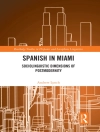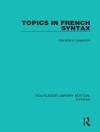This volume contains an introductory essay, the bibliography of Professor Ringe, and nineteen articles on various aspects of historical linguistics composed by current and former colleagues and students at the University of Pennsylvania and a select number of leading scholars in the field based at institutions such as Cornell University, Harvard University, Oxford University, Saarland University, University of Georgia, University of California at Los Angeles, University of Munich, and York University. The majority of contributions focus upon linguistic phylogenetics (the interrelationships among languages), Classical linguistics, and Germanic linguistics. Many of the contributions make contributions to theoretical, as well as historical, linguistics.
قائمة المحتويات
Bibliography of Don Ringe.- Subgrouping and phylogeny.- Joseph F. Eska: The Continental Celtic dialect continuum.- Ronald I. Kim: On the phylogenetic status of East Germanic.- Tandy Warnow, Steven N. Evans, & Luay Nakhleh: Progress on constructing phylogenetic networds for languages.- Linguistic reconstruction.- Jay Jasanoff: Rethinking Stang’s Law, with a note on Gk. πότνια.- Lionel S. Joseph: The sources of the *-ono- ‘god’ suffix.- Masato Kobayashi: The final glottal stop of the Kuṛux verb bases.- Michael Weiss: Very Old Latin.- Theoretical approaches to language change.- Olav Hackstein: Iceberg phenomena and synchronic rules.- Jean-François Mondon & Joseph F. Eska: Forced to FORCE? Remarks on the architecture of the left periphery of Early Irish and absolute/conjunct morphology.- Augustin Speyer: On the functional superstructure of the Noun Phrase in Indo-European.- Ann Taylor: Understanding translation effects. Lessons from the Old English Heptateuch.- Charles Yang: Phonological regularity and breakdown. An account of vowel length leveling in Middle English.- Indo-European philology and etymology.- Sara Kimball: Guests. Welcome or not.- Jared S. Klein: Asyndetic verbal pairs in the Classical Armenian Gospels and their treatment in the other five first millennium CE Indo-European versions.- H. Craig Melchert: Celt. *meh2-ró- ‘large, great’ versus Gmc. *meh1¬-ró- ‘made known, spoken of’.- Philomen Probert: ‘Between uneducated and educated, or hot and cold, or bitter and sweet … there’s a middle point’. Varro and the middle accent.- Patrick Stiles: Obscured figurae etymologicae and word origins. Two examples involving Gothic.- Brent Vine: South Oscan κλοπουστ (with an Appendix on [Osco-?]Lat. BVRVS).
عن المؤلف
Joseph F. Eska is Professor of Language Sciences at Virginia Polytechnic Institute & State University, USA. His work focuses upon language change in the Celtic languages. He particularly works within the theoretical frameworks of Laryngeal Realism and Syntactic Cartography.
Olav Hackstein is Professor and Chair in Historical and Indo-European Linguistics at the Ludwig-Maximilians University in Munich, Germany. His research interests focus on the historical morphology and syntax of the ancient Indo-European languages.
Ronald I. Kim is Associate Professor in the Department of Older Germanic Languages of the Faculty of English at Adam Mickiewicz University, Poland. His research focuses on phonological and morphological change in the Indo-European languages, primarily Balto-Slavic, Iranian, Armenian, and Tocharian, as well as dialectology and language contact.
Jean-François Mondon is Professor of World Languages who teaches both classical and modern Indo-European Languages at Minot State University, USA. His research is split between the writing of pedagogical material for ancient Indo-European languages and the application of the theoretical framework of Distributed Morphology to primarily Celtic language data.












